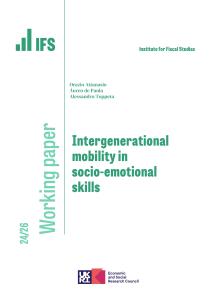This short comment examines one important trend in housing: how homeownership has changed in recent years, focusing in particular on younger adults.
Figure 1 shows the homeownership rates of working-age adults, split by age. The most dramatic changes have been for younger adults. The latest data for 2022–23 show 39% of 25- to 34-year-olds owned their home, 20 percentage points lower than the peak (59%) seen in the year 2000. The sharpest decline occurred following the Great Recession but, having reached a trough in 2015–16, homeownership rates for 25- to 34-year-olds subsequently rose by 6 percentage points by 2022–23. This modest recovery occurred both before and after the pandemic. Whether rising mortgage interest will bring this trend to a halt, or indeed reverse it, remains to be seen (our data end in March 2023).
The patterns for older working-age adults are not as dramatic but nor is there the partial recovery seen for 25- to 34-year-olds. For 35- to 44-year-olds, homeownership has stopped falling since 2015, with the homeownership rate for this age group in 2022–23 (59%) essentially the same as in the mid 2010s. It remains 7 percentage points below the 2010–11 level and 15 percentage points below the peak seen in the early 2000s. For the older working-age adults (45- to 59-year-olds), gradual declines have continued as generations of people who have found it harder to get onto the housing ladder are reaching these ages. At 69%, homeownership for this age group has fallen 7 percentage points since 2010 and is 11 percentage points below the early 2000s peak.
Previous IFS analysis (Cribb, Hood and Hoyle 2018) found that the falls in homeownership for younger adults between the mid 1990s and mid 2010s were concentrated on people on middle incomes. Figure 2 shows that the partial recovery since 2015 has also been concentrated on middle-income people, with homeownership growing by 15 percentage points for 25- to 34-year-olds on middle incomes. These people in 2022–23 had post-tax (and benefit) incomes of £29,000–£41,000 (this is the disposable incomes of an individual and their partner/spouse, if they have one). However, this still leaves middle-income young adults, along with the upper-middle (fourth quintile), as having seen the largest falls in homeownership since the mid 1990s. For older working-age groups (those aged 35–44 and 45–59), it is also the case that falls in homeownership have been largest for middle income groups.
As well as disproportionately affecting middle-income 25- to 34-year-olds, the gradual recovery in homeownership since the mid 2010s for young adults has been concentrated in certain demographics: in particular, couples (+9 percentage points since 2015 compared with +3 percentage points for singles); and people born in the UK (+7 percentage points since 2015 compared with +3 percentage points for immigrants). The increases have also been slightly larger for people living outside London and the South East and for people without children.
It is not yet clear what has driven this partial recovery. It is notable that income growth for younger adults has been better than for the population as a whole, with the real median disposable income for 25- to 34-year-olds rising by 9% from 2015–16 to 2022–23 (compared with 3% growth in the median for the population as a whole) after large falls in their earnings during and immediately after the Great Recession. At 9%, income growth for middle-income young adults has also been higher than for high-income young adults, who also only saw income growth of around 3% over the same period.
Other potential factors include the following. Outside southern England, house prices moderated, with house price-to-earnings ratios lower in the 2010s than before the Great Recession. A series of policy changes were aimed at getting more people onto the housing market, such as reductions in stamp duty for first-time buyers purchasing a property under £500,000, stamp duty holidays during the pandemic, Help to Buy, the Help to Buy ISA and the Lifetime ISA, though it is hard to know exactly how effective these were. The pandemic also meant almost everyone (had to) cut back on their expenditure, giving many a deposit that may have been harder to achieve otherwise.
Summary
Homeownership for young adults fell continuously from 2000 through to 2015, most significantly during and immediately after the Great Recession. This fall was concentrated in particular on middle-income people. Since 2015, there has been a gradual recovery in homeownership for young adults, rising by 6 percentage points back to 39% by 2022–23, the same level it was in 2010–11. This recovery has also been concentrated on middle-income people. The reasons for the recovery are not immediately clear, though it is noticeable that disposable incomes of young adults have grown markedly faster since 2015 than those of the population as a whole.
Despite the positive news since 2015, it is clear that the recovery is partial at best, with homeownership rates for 25- to 34-year-olds still 20 percentage points lower than in 2000. And lower homeownership earlier in life is now feeding through to fewer people as homeowners at older ages as they approach retirement.









